Australia’s Bureau of Meteorology has declared a La Niña weather event has begun with the expectations of increased rainfall and colder conditions to follow.
As we expect to see more rain, driving conditions can become increasingly more unfavourable and extra precautions should be taken on the road.
Torrential rain and flooding can become life threatening when driving especially if drivers are unsure how to approach a waterlogged situation.
Driving through flood waters is particularly dangerous as fast-moving water, low visibility and unseen debris can cause a situation to turn sour very quickly. It is never wise to drive through flood water as it can cause not only significant damage to your vehicle but can also result in being swept away and/or submerged.
A small vehicle can float in as little as 15cm of water and carried away by relatively slow flowing water. Hard to believe right? Check out the SES 15 to Float Campaign.
When faced with floodwater over roads it is always best to find a different route to your destination or wait for the water to recede.
Heavy rainfall can reduce your field of vision while driving and can become particularly dangerous if windscreen wipers cannot keep up. Assuming it is safe to do so, it’s recommended to pull over and wait for the conditions to improve.
During wet weather, reducing speed, avoiding sudden braking, and leaving a longer stopping distance than usual between you and the next car can prevent an accident.
Before beginning the drive, it is good practice to check the vehicle’s tyres, making sure the pressure and tread are acceptable especially when expecting wet weather conditions on the road.
Checking the weather, planning your route, and rescheduling a journey to avoid bad weather conditions for driving is an effective way to reduce the chances of encountering poor circumstances and added dangers.
STAY ALERT. STAY SAFE. STAY ALIVE.




















